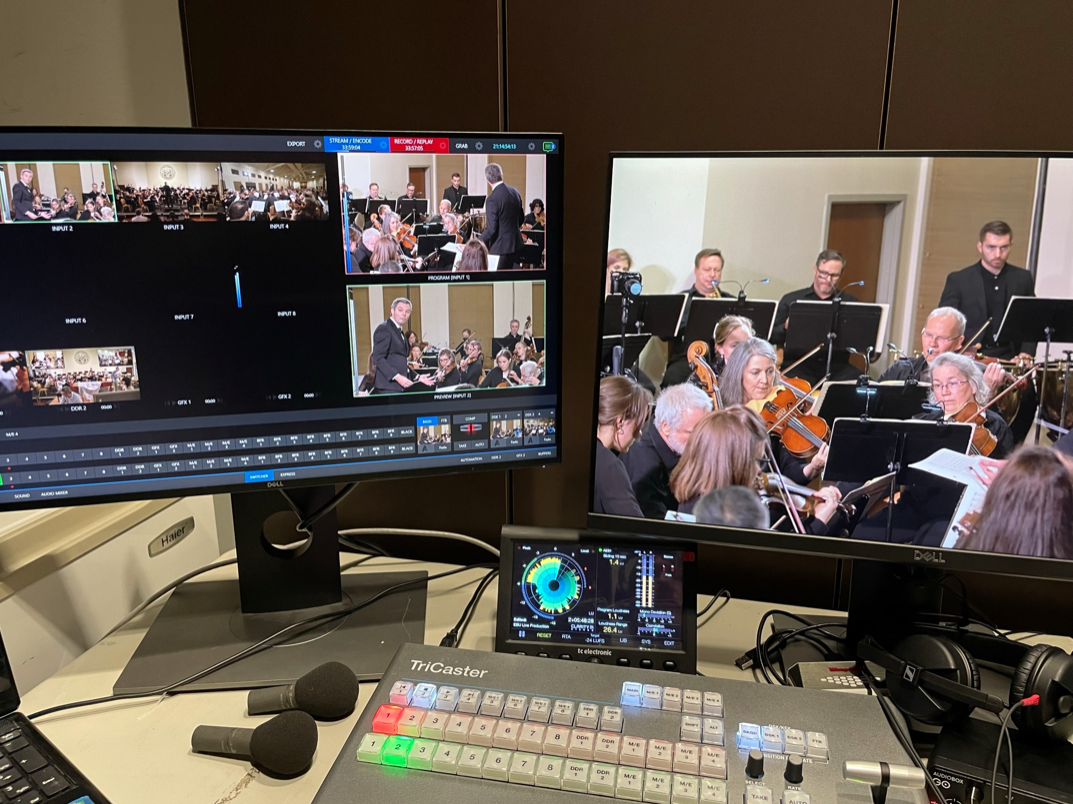Very Special for two reasons. Firstly, this performance is one of half a dozen in the US using using authentic period instruments at A=430. It was also a milestone production – as far as the technical and creative freedoms as well as the challenges.
I’ll back up and tell you about my interest in orchestral video productions. It peaked during lockdown. Everybody was posting their archives. We all remember. At the time I was two years into doing video professionally, and was inspired seeing HR Sinfonie Orchester (Frankfurt), Teatro La Fenice (Venice), Orchestre de Paris, and Mariinsky Theater (St Petersburg). Little did I know I was about to produce a season’s worth of orchestral performances with the symphony (albeit with one hand tied behind my back.)
Back to 2022, with the Beethoven performance fast approaching, I was thinking how to light this stage and mic it. The challenges were immense. Hanging the mics is something I’ve wanted to do for about a decade, because it means not only ideal placements can be made, but sight-lines can be clear.
The lighting presented my biggest challenge, and I am currently obsessed with finding a better solution than we arrived at, but while I obsess on my challenges privately, I’ll move on to talk about the many successes on this production. I do want to acknowledge Natalie George, who jumped in pretty late in the game with her team and extremely professionally handled the rental, delivery, rigging and programming of the lights.
Having the flown mics was incredible. It seemed to take forever to get them up there, but after learning how to tie the right knots and getting extraordinary support from Will Konitzer, we got them up. A perfect DECCA TREE – a classic setup that provides a spacious and open capture – basically a triangle of three mics above the conductor’s head. And to fill out the strings sound, a flank to the left and right. The audience may have not even noticed these guys hanging up there.




I want to acknowledge help from two colleagues other than Will in this pursuit: Brad Sayles – the recording engineer for the Houston Symphony, who also plays sax, composes and went to my alma mater Michigan State. Brad made himself available to talk through the mic placements and choices for which I am incredibly grateful. The other colleague I’d like to thank is Roberto Toledo – himself from the Valley, who is the chief engineer at New World Symphony. He’s always posting about mics he’s hanging, so I gave him a call to get some pointers on how to rig these up, and again, super grateful that he made some time to chat and share his expertise.
Image-wise, doing this type of production is a balancing act between artistic and practical. We want to show details and cool shots that are interesting and fun to look at, but also satisfy the musician viewer’s who are compelled to see certain things at certain times. Everyone has different preferences, and as a violinist, I’m sure I have a bias that is invisible to me as well. We used 4 cameras that were synced up to get our four main shots: the orchestra in total (wide shot), the reverse conductor shot, and two cameras with seasoned operators – Christopher Morse and Steve Conn. Camera 5 was a reverse shot on the concert-master, and camera six was a shot of the horns.




In retrospect, I would have made camera six a shot of the entire woodwind section, and had an eighth camera just on the brass. A ninth camera just on the piano soloist would have been the icing on the cake. That would have given us absolute complete coverage to not miss any solos or solis. But with six we had excellent coverage and with the two cameras doing close ups the viewer can get the feeling of being right there in the middle of the action. And there was a lot of action.
I’ll just briefly mention here the technical achievement of having not only frame synced cameras (the four main cameras), but also have the multi-tracked audio recording having sample rate sync resolved to the time-code reference. That’s some fancy words for saying that for any 48 thousandth of a second – all cameras and all microphones can be recalled in post production by just typing in a number (or more likely copying and pasting a number), and they are all present exactly, precisely that particular moment in time. Now, we will continue to expand our system as we are able to grow that 4 camera capability to 8, but for now that gives us an incredible head start on saving time in post and makes easy work behind the scenes.
Finally, since we have a TriCaster, and it wasn’t in use, I was able to have it running throughout the rehearsals and I’m really happy that I could provide the musical director a copy of early rehearsals showing the orchestra with an inset picture of him in a reverse shot. I know this reference was a great resource which added to the success of the performance.


If you have any questions about this production please reach out, I’m sure I’d be happy to talk about it!
You can watch the final products here:

